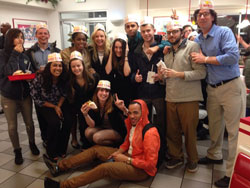Various companies have been favoring the business tactic of “buy one, give one”, meaning a customer buys the product, and the company donates an equivalent item to someone in need. However, there has been a split view on how much this really helps the ones in need.
TOMS Shoes has been known to be one of the very first companies to do this “for-profit” method. They call this the “One for One.” While on a trip volunteering outside of Buenos Aires, Argentina, the company’s founder Blake Mycoskie noticed a lack of shoes not only in Argentina but also in other developing countries and how this was a bigger problem than it seemed. He then created this company where if one consumer buys a pair of shoes, another pair of shoes is donated to a third world country. With the launch of the company in May 2006, TOMS sold more than 10,000 pairs of shoes in the first six months. The initial batch of free shoes was distributed in Oct. 2006 to Argentine children.
Since then, the canvas shoes have been given to children in 40 countries worldwide, including the U.S. and have given away over 1 million pairs. Since then, many other companies have picked up this idea such as Warby Parker. For every pair of glasses a customer buys from Warby Parker they cover the cost of sourcing and producing a second pair of glasses for partners like the social enterprise VisionSpring, and Kno Clothing, who donate articles of clothing to someone in need.
Companies like these have given the opportunity for consumers to give back in such a simple way. “There isn’t much more to it than that,” Neil Blumenthal, a co-founder of Warby Parker said. “That’s the beauty of it.” According to a Cone Communication Public Relations & Marketing study, 80 percent of Americans are likely to switch brands, if comparable in price and quality, to one that supports a social cause.
Specialist Professor of Management and Decision Sciences John S. Buzza, said, “This is a wonderful initiative and one that all companies should look at. Companies that produce food, medicines, clothing, farm equipment and educational materials etc., should be the target. ‘Remember to give a man a fish is fine for today but to teach him how to fish can sustain him for life’.”
However, many critics have actually seen more negatives than positives when it comes to these “buy one, give one” companies. Some have said that TOMS efforts to help the poverty of other countries does nothing to address the root of the problem. In an article, Questioning the TOMS Shoes Model for Social Enterprise, Andriana Herrera said, “Here’s my concern: Rather than solve the root cause of why children don’t have shoes, TOMS has created a business model that actually needs poor children without shoes in order to sell its shoes. Those children are an essential part of the company’s marketing.”
In an article from The New Yorker called, “Beyond Buy-One-Give-One Retail,” April Joyner said, “Giving children shoes may enable them to attend school, but those children may still go hungry at night. Some have argued that TOMS donations may actually cause harm, by reducing demand for locally produced goods. If TOMS gives free shoes to people in Ghana, could that kill off local shoe stores?”
Associate Professor Dr Rosemary A. Barbera, said “I actually think that organizations like Tom’s do more harm than good. They are always run by people who are not part of the local area and so they run the risk of ‘white savior syndrome.’ They also run the risk of being charitable efforts that only put poor patches on immense social injustices.
In another article from the New York Times, “Shopping for a Better World,” Sarika Bansal said, “On a recent trip to Ethiopia I met with TOMS employees, who said that shoes promote education because children are often barred from entering schools barefoot. However, when I met one of their Ethiopian giving partners, the International Orthodox Christian Charities, I learned that they distribute the shoes in schools — to children who, presumably, already own shoes.”
Bansal, in her article, contrasted TOMS efforts to Warby Parker’s similar tactic. “Warby Parker made a conscious decision to support the sale and not donation of glasses. Donations, Blumenthal said, can “create perverse incentives that create a culture of dependence and at times can negatively impact the economy.” The article said, There are also practical considerations to this. ‘People are constantly breaking or losing their glasses, or their prescriptions are changing, or new people are finding that they need new glasses,’ he said. ‘You need a permanent presence [in a community], and that can’t be sustained by giving away stuff for free.'”
Taylor Buttero, a freshman biology major said, “I think it is a good idea, but the execution by major companies can be improved upon to help not only the people but the country as well.”
Erin Comiskey, a freshman health studies major, said, “I think the companies that are offering to donate a part of their profit to charity use this as a business strategy. Consumers, who are attracted to charity, or better yet, the specific cause the charity is for, are more likely to purchase the companies’ products as opposed to competitors. The motives of businesses, especially large corporations, are to make the largest profit possible– not to help those in need, despite the donations of profits and/or products.”
Bansal said in her article, “The core idea of [Buy 1, Give 1] remains a powerful one, as it engages customers in the developed world in a way many philanthropic programs do not. To be effective, however, the B1G1 program must be designed to be sustainable and consistent with the needs of the developing world recipients.”
TOMS has recently added coffee for sale, and is working with Water for People that for every bag of coffee bought, they will provide clean water for someone in a developing country.



